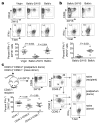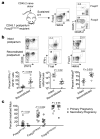Pregnancy imprints regulatory memory that sustains anergy to fetal antigen
- PMID: 23023128
- PMCID: PMC3465465
- DOI: 10.1038/nature11462
Pregnancy imprints regulatory memory that sustains anergy to fetal antigen
Abstract
Pregnancy is an intricately orchestrated process where immune effector cells with fetal specificity are selectively silenced. This requires the sustained expansion of immune-suppressive maternal FOXP3(+) regulatory T cells (T(reg) cells), because even transient partial ablation triggers fetal-specific effector T-cell activation and pregnancy loss. In turn, many idiopathic pregnancy complications proposed to originate from disrupted fetal tolerance are associated with blunted maternal T(reg) expansion. Importantly, however, the antigen specificity and cellular origin of maternal T(reg) cells that accumulate during gestation remain incompletely defined. Here we show that pregnancy selectively stimulates the accumulation of maternal FOXP3(+) CD4 cells with fetal specificity using tetramer-based enrichment that allows the identification of rare endogenous T cells. Interestingly, after delivery, fetal-specific T(reg) cells persist at elevated levels, maintain tolerance to pre-existing fetal antigen, and rapidly re-accumulate during subsequent pregnancy. The accelerated expansion of T(reg) cells during secondary pregnancy was driven almost exclusively by proliferation of fetal-specific FOXP3(+) cells retained from prior pregnancy, whereas induced FOXP3 expression and proliferation of pre-existing FOXP3(+) cells each contribute to T(reg) expansion during primary pregnancy. Furthermore, fetal resorption in secondary compared with primary pregnancy becomes more resilient to partial maternal FOXP3(+) cell ablation. Thus, pregnancy imprints FOXP3(+) CD4 cells that sustain protective regulatory memory to fetal antigen. We anticipate that these findings will spark further investigation on maternal regulatory T-cell specificity that unlocks new strategies for improving pregnancy outcomes and novel approaches for therapeutically exploiting T(reg) cell memory.
Conflict of interest statement
The authors declare no competing financial interests.
Figures




Comment in
-
Immunology: Tolerating pregnancy.Nature. 2012 Oct 4;490(7418):47-8. doi: 10.1038/490047a. Nature. 2012. PMID: 23038465 No abstract available.
References
-
- Prins JR, et al. Preeclampsia is associated with lower percentages of regulatory T cells in maternal blood. Hypertens Pregnancy. 2009;28:300–311. - PubMed
-
- Santner-Nanan B, et al. Systemic increase in the ratio between Foxp3+ and IL-17-producing CD4+ T cells in healthy pregnancy but not in preeclampsia. J Immunol. 2009;183:7023–7030. - PubMed
-
- Sasaki Y, et al. Decidual and peripheral blood CD4+CD25+ regulatory T cells in early pregnancy subjects and spontaneous abortion cases. Molecular human reproduction. 2004;10:347–353. - PubMed
Publication types
MeSH terms
Substances
Grants and funding
LinkOut - more resources
Full Text Sources
Other Literature Sources
Medical
Research Materials

